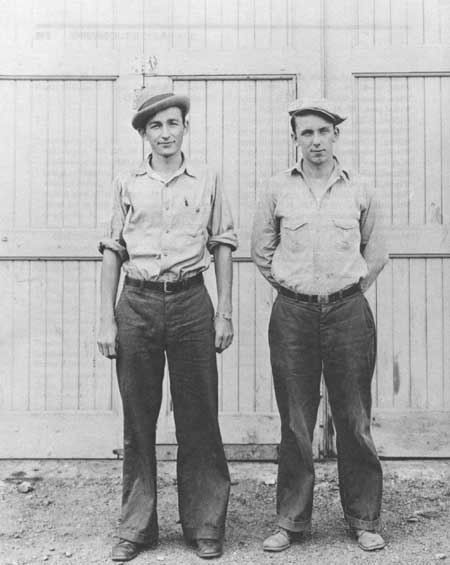|
Gateways to Commerce: The U.S. Army Corps of Engineers' 9-Foot Channel Project on the Upper Mississippi River |

|
ACKNOWLEDGMENTS
Gateways To Commerce. The U.S. Army Corps of Engineers' 9-Foot Channel Project on the Upper Mississippi River is the second in a series of National Park Service monographs about cultural resources in the Rocky Mountain Region. The first monograph, published in 1989, focused on archaeological resources within Canyonlands National Park. Gateways to Commerce, which documents the construction of one of the Nation's largest navigation improvement projects, is the result of three Historic American Engineering Record (HAER) studies that were completed under the direction of the Rocky Mountain Regional Office.
The Historic American Engineering Record program was established in 1969 by the National Park Service, the American Society of Civil Engineers, and the Library of Congress. The purpose of the program is to document the Nation's historic industrial, engineering, and transportation resources, as well as the working and living conditions of the people associated with them. Under the tripartite agreement, the National Park Service administers the HAER program with funds appropriated by Congress and supplemented by outside donations. The Rocky Mountain Regional Office of the National Park Service is responsible for preparing and reviewing HAER documents in a 16-state region encompassing Colorado, Illinois, Iowa, Kansas, Minnesota, Missouri, Montana, Nebraska, New Mexico, North Dakota, Oklahoma, South Dakota, Texas, Utah, Wisconsin, and Wyoming.

|
| Inspection Personnel, Lock and Dam No. 5A, c. 1936. (American Heritage Center, University of Wyoming) |
Funding for the HAER documentation of the Upper Mississippi River 9-Foot Channel Project was provided by the U.S. Army Corps of Engineers. Between 1986 and 1990, the St. Paul, Rock Island, and St. Louis Districts of the Corps of Engineers entered into interagency agreements with the Rocky Mountain Regional Office to document the 9-foot channel. The St. Louis District also provided funding to produce Gateways to Commerce, a result of that HAER documentation.
Many people have worked on this publication. William Patrick O'Brien, Mary Rathbun, and Patrick O'Bannon wrote and researched the individual district histories of the 9-Foot Channel Project, and graciously allowed their work to be synthesized into this single document. Christine Whitacre, an historian with the Rocky Mountain Regional Office, edited the three highly technical HAER manuscripts into a very readable book. Martin Reuss, Senior Historian for the Corps of Engineers, reviewed the manuscript, as did Leland Johnson, author of several histories about the Corps of Engineers, and Donald Jackson, Assistant Professor of History at Lafayette College in Easton, Pennsylvania. Cultural resource specialists in the Corps' district offices also reviewed the manuscript, and assisted in obtaining research materials and photographs. These include John Anfinson of the St. Paul District, Ron Deiss of the Rock Island District, and Terry Norris of the St. Louis District. While many photographs in this publication are historic, the contemporary photographs are the work of Clayton Fraser, Peter Rathbun, and John P. Herr.
Many National Park Service staff persons contributed their time, effort, and ideas to this project. Rodd L. Wheaton, Chief, Division of Cultural Resources of the Rocky Mountain Regional Office, provided support and direction, as did Robert L. Spude, Chief of the Branch of National Preservation Programs. Senior Historian Gregory D. Kendrick supervises the HABS/HAER program in the Rocky Mountain Region, and coordinated this project. Historians Julie A. Corona and Joan M. DeGraff provided technical support. Architect Catherine Colby drew the map and illustrated cross-section. Caroline Russell, an historian with the National Park Service's HABS/HAER office in Washington, D.C., assisted in obtaining the photographs. Special thanks are also offered to Richard M. Kohen of the Rocky Mountain Regional Office for his excellent book design and layout.
Researchers wishing to learn more about the 9-Foot Channel Project are encouraged to read the original HAER reports. The reports are located in the Prints and Photographs Division of the Library of Congress in Washington, D.C.; copies are in the files of the National Park Service, Rocky Mountain Regional Office. In addition to containing more detailed information, the HAER reports acknowledge the efforts of the many other individuals, too numerous to mention here, whose work contributed to this publication.
Michael D. Snyder
Associate Regional Director
Rocky Mountain Region
National Park Service
February 1992
| <<< Previous | <<< Contents>>> |
rmr/2/ack.htm
Last Updated: 01-Feb-2008